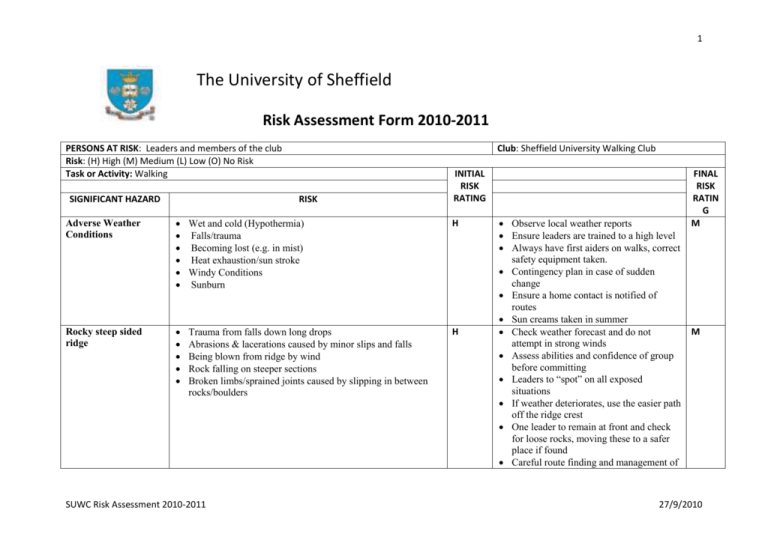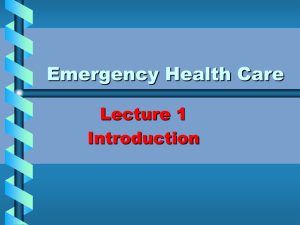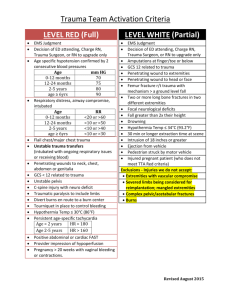Risk Assessment - Sheffield University Walking Club
advertisement

1 The University of Sheffield Risk Assessment Form 2010-2011 PERSONS AT RISK: Leaders and members of the club Risk: (H) High (M) Medium (L) Low (O) No Risk Task or Activity: Walking SIGNIFICANT HAZARD Club: Sheffield University Walking Club RISK INITIAL RISK RATING Adverse Weather Conditions Wet and cold (Hypothermia) Falls/trauma Becoming lost (e.g. in mist) Heat exhaustion/sun stroke Windy Conditions Sunburn H Rocky steep sided ridge H Trauma from falls down long drops Abrasions & lacerations caused by minor slips and falls Being blown from ridge by wind Rock falling on steeper sections Broken limbs/sprained joints caused by slipping in between rocks/boulders SUWC Risk Assessment 2010-2011 Observe local weather reports Ensure leaders are trained to a high level Always have first aiders on walks, correct safety equipment taken. Contingency plan in case of sudden change Ensure a home contact is notified of routes Sun creams taken in summer Check weather forecast and do not attempt in strong winds Assess abilities and confidence of group before committing Leaders to “spot” on all exposed situations If weather deteriorates, use the easier path off the ridge crest One leader to remain at front and check for loose rocks, moving these to a safer place if found Careful route finding and management of FINAL RISK RATIN G M M 27/9/2010 2 High and steep mountains in winter conditions Exposed situations with risk of long fall Possibility of very cold summit temperatures Ice may form on rocks at altitude Risk of avalanche if there is significant snow on ground or snowfall Risk of strong wind on narrow ridges. H Minor Falls and Slips Stream or River crossings Consequences of previous medical conditions Becoming lost (both of group and individuals from the group) Broken limbs Sprained joints Pulled muscles Wet and cold (hypothermia) Unconsciousness Wet and cold (hypothermia) Sprained joints Broken limbs Many medical conditions could be exacerbated by conditions on walks and/or could be more dangerous when they result in an acute condition further from medical assistance (e.g. asthma, diabetes mellitus, epilepsy, allergies) Wet and cold (if weather changes and group stays out longer) Hypothermia Disorientation Falls, trauma SUWC Risk Assessment 2010-2011 H M M M group to avoid dangerous positions Get mountain weather and avalanche forecasts, summit temps, wind speed and freezing level Avoid scrambles if possible, leaders should spot any exposed places that can’t be avoided by careful route planning Avoid going above freezing level Avoid narrow ridges in strong wind Advise members on clothing and equipment requirements Check avalanche forecast www.sais.gov.uk and avoid areas that are at risk Avoid crossing large areas of deep snow on slopes between 25 and 45 degrees. Suitable equipment (esp. boots) Good navigation Avoid dangerous/slippy terrain in poor weather conditions First aider on every walk Check weather forecasts Plan alternative routes in case of flooding Ensure experienced leaders are leading First aider on every walk Members are encouraged to let a first aider know of any existing medical conditions at the start of every walk. Navigation training for all leaders Only up-to date maps used Keep regular account of all group members Frequent reference to map and compass Leaders work together when assessing M M L L L 27/9/2010 3 current position. Education of members and leaders Frequent rests Correct clothing taken First aider present Cold fluids taken Faint Collapse Vomit Cramp Falls Dehydration Falls Wet and cold (hypothermia) Becoming lost M M Major Trauma accidents (such as falling off a cliff in mist) Severe fractions Lacerations with possible blood loss Paralysis Drowning Death. L Road traffic accident (while walking) Severe fractions Lacerations with possible blood loss Paralysis Loss of consciousness Death L Road traffic accident (while in a vehicle) Severe fractions Lacerations with possible blood loss Paralysis Loss of consciousness Death. L Ensure participants carry torches, preferably head torches Carry spare torches Ensure all leaders have experience with night navigation Stick to known paths. Navigation training for all leaders Check of weather reports, changing routes if appropriate Stick to good paths if possible Keep regular account of all group members First aider always present. Walk on right-hand side of road well into the side Walk in single file Good discipline of group Verbal warning of oncoming traffic First aider present. Travel on public transport for single day walks Minibus training for all drivers Insurance for drivers and vehicles, Membership of breakdown service Ensure all club and Union safety guidelines are followed at all times Heat exhaustion Night walking SUWC Risk Assessment 2010-2011 L L L L L 27/9/2010 4 Drunkenness Falls/trauma, RTA on way to/from socials Falls and trauma Fights Fractures Loss of consciousness Aspiration pneumonia. Falls, fractures RTA related injuries L Acceptance and awareness of every individual's responsibility, at least one sober committee member present L L Acceptance and awareness of every individual's responsibility and risk of getting to a social Overall Risk: L Comments: As long as all good practise guidelines and risk assessments are adhered to, there should be a very low chance of any problems occurring. L Additional References, Tasks etc. Undertaken By: Other Persons Consulted: Date: 14/10/2010 Emily Beardon (SUWC Safety and Training Officer (10-11) Max Holliday (Union Safety Advisor) SUWC Risk Assessment 2010-2011 Revision Date 14th October 2011 27/9/2010










